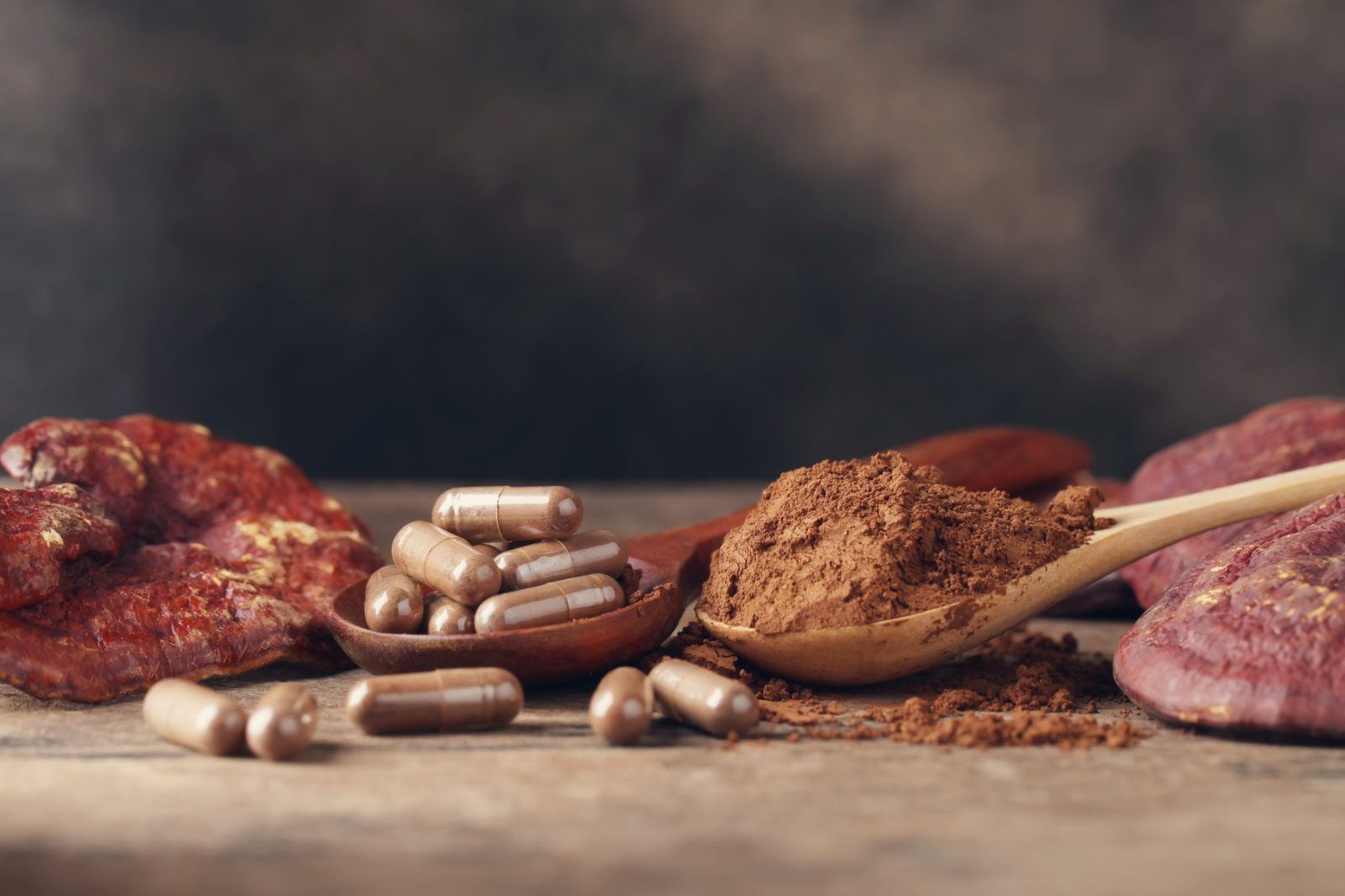Although plenty of mushrooms are edible, only a small percentage are worth eating. Reishi is one such mushroom, not only is very healing it is also a functional food – as it has amazing potential for our health and vitality. It has been sought out for over 4000 years by mountain sages, priests, monks, emperors and empresses (Serrano, R.B., 2011).
Reishi is a polypores mushrooms (Obadai, M., et al., 2017) that infests trees (primarily oak) and causes the tree to rot, with different varieties of reishi mushroom having distinct biodegradative potential which will have an influence of the quality of benefits the mushroom contains (Kuhar, F., et al., 2018). The fruiting bodies range in colour from a reddish-orange to black. The fruiting body flesh can be soft while other varieties are incredibly tough and bark like (Hobbs, C., 1986).
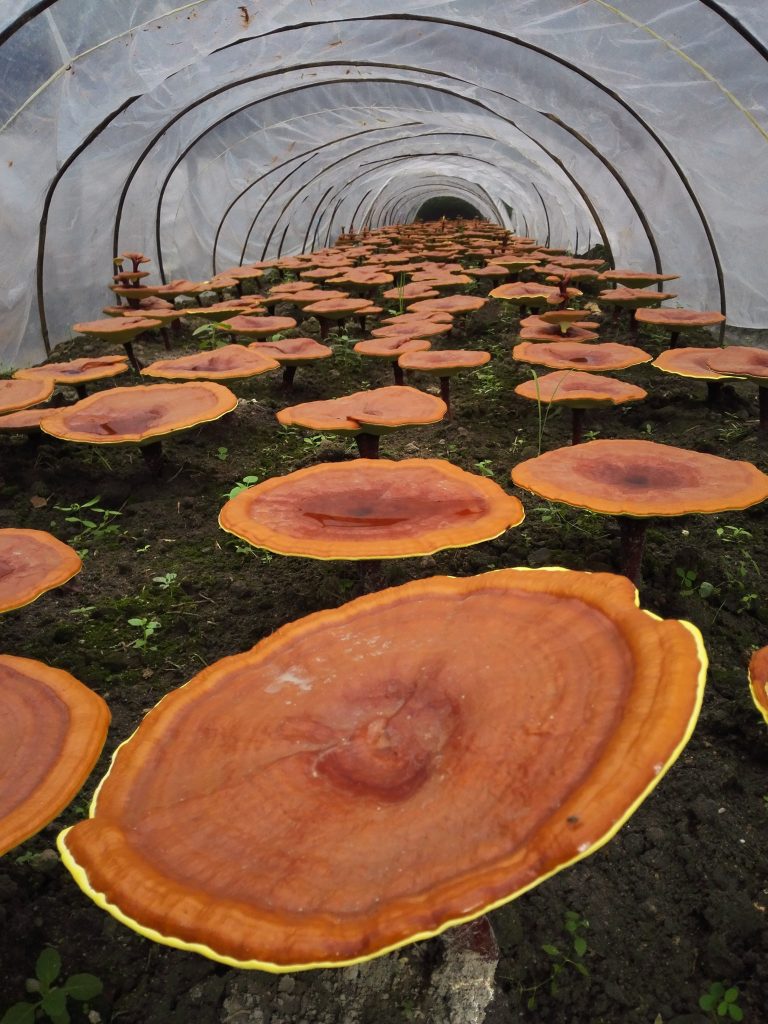
The Mushroom of Immortality – A History
Reishi has a long history of being a medicinal plant and has for most of its medical practice been seen as a mushroom of immortality (Serrano, R.B., 2011). For well over 4000 years it has been handled as a part of Traditional Medicine in China and Japan (Hobbs, C., 1986). In 2730BC, Emperor Shennong of China declared that red reishi was the most important elixir as a result of its amazing health benefits, primarily its ability to cure disease and slow down aging – back then it was thought to bring about immortality (Chaput, M., 2013). From that time its popularity continued to grow in the Orient, those its medicinal application was often left to those of the upper class. During the Pei Sung Dynasty (1004-1007AD) for example, Emperor Chen Sung made an avowing that all reishi be brought to his palace, records would show an approximate total of 10,000 pieces(McKenna, D.J., 2011).
Traditional Uses of Reishi
Eastern Europe: Reishi was used, dried, as a decoration for a mantle place.
China – Yung Dynasty: Reishi was used to adorn material goods such as jade jewelry, belts, and carpets.
Japan: Reishi was hung in home hallways as a sign of vanquishing evil from the living space. It was also given to young brides as a means to bring them good fortune in their new home and to ensure that there would be no difficulty with their new family (McKenna, D.J., 2011).
Cultivation of Reishi
Reishi is a very rare mushroom to find in the wild, with a ratio of about 1 in every 4000 mushrooms being a species of reishi (Meunick, J., 2015) – resulting in it being called the “phantom mushroom” in Japan. It’s harvesting is difficult and as a result, for most of its medicinal and culinary uses, it was left to nobility (Hobbs, C., 1986). Cultivation of reishi began in Japan in the 1970s (in the 1980s in China) (McKenna, D.J., et al., 2011) making the mushroom more accessible and less expensive. Cultivation began with Shigeaki Mori who over 15 years had developed an intricate process for growing the mushroom in a closed environment utilizing old plum tree sawdust to grow reishi spores. In Japan, this process is primarily used to cultivate red reishi(Hobbs, C., 1986).
Reishi cultivation requires a specific environment and nutrients to develop all the beneficial properties that it is revered for. If the process is inferior the product will be as well, the reishi will be harvested immature and will have a poor amount of nutritional compounds within it. Cultivation of reishi that takes between 3-5 months yields poor quality products, it takes about a year for the mushroom to fully develop and obtain its positive medicinal benefits (Chaput, M., 2013).
Because reishi requires more time during cultivation to develop as well as particular light and nutrient conditions to obtain a good quality product (Kuhar, F., et al., 2018) it is important to pay close attention to where the product is coming from. Japan has high standards for the cultivation of the mushroom (primarily red reishi) and has a designation brought from the “Japan Reishi Association” to determine which reishi products are of the highest quality (Chaput, M., 2013).
Proper extraction is also necessary for the nutrients to be derived. In culinary practices using varieties of reishi that are soft enough to eat, cooking the fruiting body and consuming it is beneficial, but the greatest benefits are seen when the mushroom is boiled (Cilerdzic, J., Kosanic, M., et al., 2016). The optimal process of extraction occurs from boiling the fruiting body of the reishi for several hours and letting the liquid condense and dry again. After this occurs the reishi is ground down to a powder and its active ingredients are finally bioavailable. When the boiling of the mushroom does not occur nutritional benefits will still be derived but not reishi’s full benefits (Chaput, M., 2013).

Type of Reishi
There are over 80 distinct species of Ganoderma worldwide. Distinctions between different varieties of reishi are done by molecular techniques as they are often very common, in appearance and constituents (Obodai, M., et al., 2017).
Ganoderma lucidum
Used in Traditional Chinese Medicine, it is also known as red reishi. This variety of reishi grows exclusively on hardwood trees (primarily oak, in Japan 99% of G.lucidum in the wild grows on plum trees) across Asia, the South Pacific, in Southern Europe and the Southwestern United States – across the East Coast, the Gulf Coast and the South West (Hobbs, C., 1986). It is an excellent free radical scavenger, antifungal and very effective against Salmonella typhimurium parasitic infection of the body (Cilerdzic, J., et al., 2016).
Ganoderma tsugae
In the northeastern parts of North America, this type of reishi grows on hemlock trees, birch, and maple. It is at its freshest from May to July. It is a large and fatty mushroom (Hobbs, C., 1986)
Ganoderma applantum
This variety of reishi is rather hard and woody. It grows to about 2-30 inches in width and needs to be cut off with a saw (Hobbs, C., 1986).
Ganoderma oregonense
This variety of reishi is found along the west coast of North America, Scattered throughout British Columbia and California, growing on fir and hemlock into a large and fatty mushroom. This variety of reishi does not have a historical use as a traditional remedy and its current usage is often as a substitute for G.lucidum in natural health products. Nonetheless, it does contain antibacterial properties in its fruiting body (Hobbs, C., 1986).
Ganoderma japonicum
It is found growing on decaying tropical bamboo around Southeast Asia, particularly Malaysia where it has been used by indigenous tribes (Orang Asli) for hundreds of years – one of the uses was to treat epilepsy in children. It has been found to have radical scavenging properties as well as being hepatoprotective, anti-inflammatory and genoprotective (Tan, W.C., et al., 2015).
G. japonicum further benefits include the protection and detoxification of the liver, improves microcirculation and blood flow as well as providing systemic protection for individuals who are receiving chemotherapy or radiation treatment (Hobbs, C., 1986).
Ganoderma sinense
This variety of reishi is very sweet. It has a history, in traditional medicine, of being used in the treatment of deafness and arthritic joints. It is beneficial in improving one’s complexion, increasing stamina and reducing inflammation – making it great for individuals with arthritis and mild adrenal insufficiency (Hobbs, C., 1986).
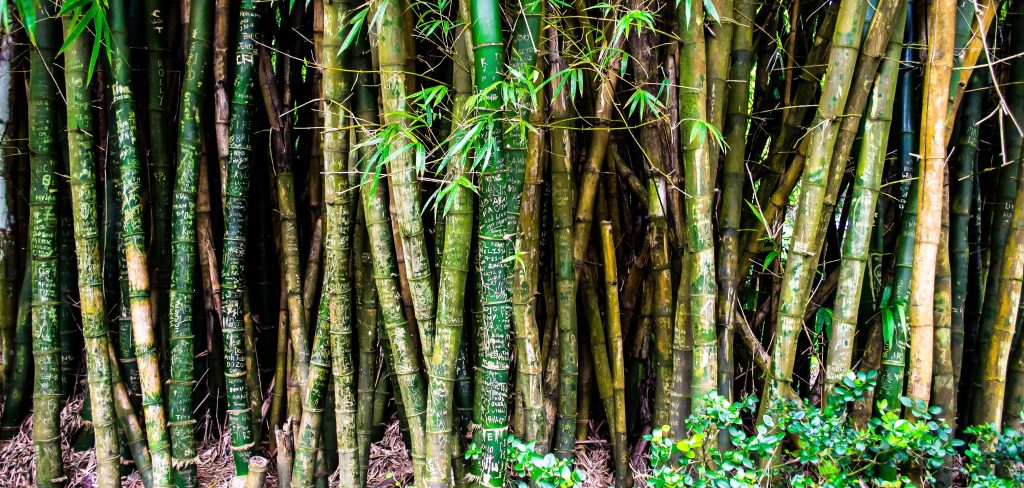
Nutritional Constituents of Reishi
Polysaccharides
Polysaccharides are long-chained sugars such as glycogen, starches, and fiber that are extracted from the fruiting body, spores, and mycelia of reishi (Suarez-Arrayo, I.J., 2017). They provide the body with energy, they keep us full and help with reducing toxins. Polysaccharides in reishi (Over 100 different varieties) also have many health benefits, such as suppressing and eliminating pathogenic invaders that enter the body such as viruses, bacteria, and yeast (Candida) (Serrano, R.B., 2011)(Page, L., 2009). They also contain anti-tumor and immunostimulating actions (Cassileth, B.R., et al., 2010). When reishi is water extracted using the fruiting body, 51% of the result is polysaccharides (Hobbs, C., 1986).
Polysaccharides in reishi exhibit anticancer benefits in tumor therapy by improving the effectiveness of the immune system, reducing the likelihood of cellular damage as a result of radiation (Suarez-Arrayo, I.J., 2017). Further cancer-fighting benefits of reishi’s polysaccharides include their increase in the body’s apoptosis and cellular differentiation (death of cancerous cells and the distinction of malignant cells). They also aid in strengthening the spleen (immune system organ) (Chaput, M., 2013).
A few Polysaccharides in Reishi
- Beta-D-glucans (Effective against sarcoma)
- Gamma-D mannans
- Heteropolysaccharides
- Glycoproteins or proteoglycans
Triterpenes/Triterpenoid
Triterpenes are plant secondary compounds (often isolated from spores) made up of one or more isoprene units that contain anti-inflammatory and antitumorigenic activities. Ganoderic acid, as we now know is a triterpene, but it is not alone. There are between 140-200 distinct triterpenes isolated in reishi, such as lucidenic acid, lipid alkaloids, glucosides, coumarins, and volatile oils are also triterpenes found in Reishi and they have very beneficial functions on the body. These compounds exhibit adaptogenic and antihypertensive actions beneficially affecting the brain and adrenals, areas of the body that concentrate stress and our way to process it effectively as well as being beneficial against cancer by weakening cancer cell membranes(Cassileth, B.R., et al., 2010)(Suarez-Arrayo, I.J., et al., 2017).
Ganoderic Acid
Ganoderic Acid is a triterpenoid (along with lucidenic acid), an isolated compound found in Ganoderma mushrooms, which has been shown to extensive beneficial effects on the body. These include; antioxidant, anti-inflammatory, antihypertension, antibacterial, antiviral, antiasthma, antitumoral, anti-HIV, anti-aggregation, cholesterol balance, hepatoprotective, etc (Hsu, C.L., 2014). Due to the presence of ganoderic acid, the immune system is stimulated and regulated making it very beneficial for individuals with autoimmune diseases. This triterpenoid also inhibits histamine release, improves oxygen utilization and liver function (Serrano, R.B., 2011).
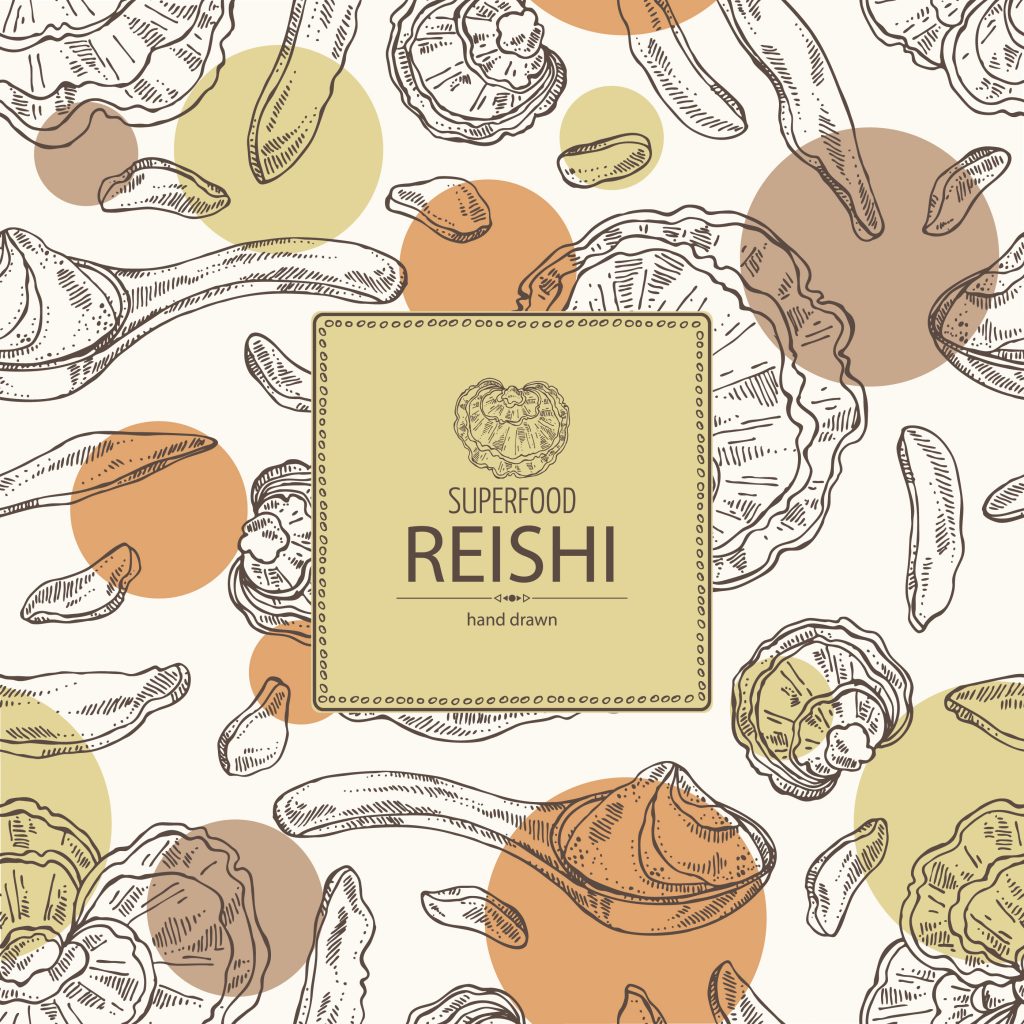
Traditional Chinese Medicine and Reishi
Reishi’s Chinese name is Ling Zhi and it is known as a Tonic or Superior Herb in Traditional Chinese Medicine. It is believed that the mushroom will provide a long healthy, happy, and vibrant life for the individuals who use it. Reishi is also among the most treasurable herbs that form the Superior Herbalism of the Orient which also includes, ginseng, Schizandra fruit, asparagus root, gynostemma pentaphyllum and Rhodiola (Serrano, R.B., 2011).
An important theoretical foundation of Traditional Chinese Medicine is the concept of the three treasures, which include the Jing (Essence), Qi (Vitality), and Shen (Spirit). It is believed that when these parts of our body and spirit begin to waver that we have the potential to feel unwell, that is why it is important to these three treasures with tonics. Tonics are made from natural herbs, plants, and minerals and they are used to revitalize the Jing, Qi, and Shen of an individual. Reishi can be used as a tonic for each treasure (Serrano, R.B., 2011).
Jing Tonic made of Reishi
This tonic will lengthen the individual’s life when used over a long period. Will build up one’s primal power and restore wasted or poor energy. By doing this you will be better at handling stressful situations (Ibid).
Qi Tonic made of Reishi
Though a mild sedative, this reishi Qi tonic also aids in restoring energy and improving immune function. Beneficial for individuals with allergies or autoimmune disease as well as those who have issues with their liver and lungs. Improves blood flow and cardiovascular health (ibid).
Shen Tonic made of Reishi
Reishi is very protective of one’s spirit. The Shen tonic of reishi will bring about peacefulness, nurture the body and mind and stimulate intelligence, wisdom and spiritual insight. Improves overall quality of life (ibid).
Different Colours of Reishi and TCM
The different colors of reishi are reflective of the five elements, purple though it is not an official element, has been used in Taoist practice to open up the heart and therefore can be connected with the fire element.
Red Reishi
Akashiba: Bitter taste. This type of reishi is most potent in its benefit of the internal organs and on one’s mental health. It aids in increasing brain plasticity, immune function, and adrenal health.
Blue Reishi
Aoshiba: Sour Taste. Aids in improving eyesight and liver function and has a calming effect on the body and mind.
Purple Reishi
Murasakishiba: Sweet in taste. This variety of reishi aids in improving joint and muscle health and function as well as reducing inflammation in these areas and systemically. Purple Reishi has also been shown to improves one’s complexion and overall skin health, as well as improve the health of ears and prevent their infection.
Black Reishi
Kuroshiba: This variety of Reishi has a very salty taste to it. It possesses kidney protective properties.
White Reishi
Shiroshiba: Spicy, hot and pungent in taste. It has been shown to improve lung functioning and give the user more courage and will.
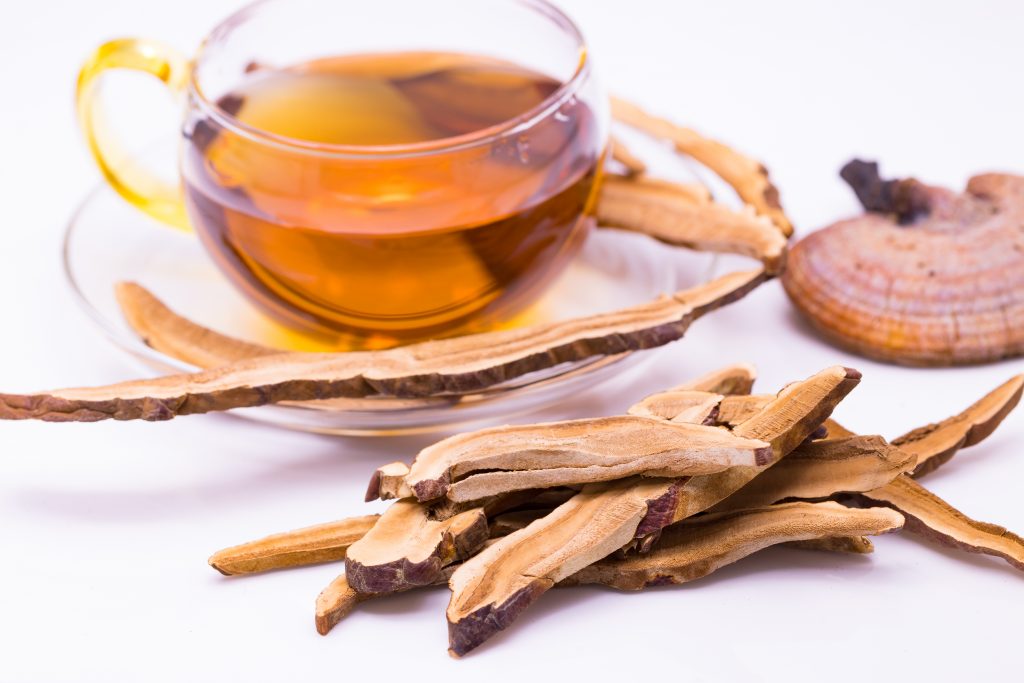
Positive Benefits and Properties of Reishi
- reduces the side effects of chem therapy/radiation – antitumoral
- boost the immune system
- antiviral activity
- slows aging
- aids in rapid wound healing
- detoxifies the liver
- improves circulation
- increases stamina
- improves blood flow
- prevents clumping of platelets
- reduces systemic inflammation
- Increases natural killer cell activity
- (Balch, P.A., 2003) (Bharadvaj, D., 2008).
Reishi used in the Treatment of
- Cancer
- Myasthenia gravis
- Migraines
- Candida & yeast infections
- Epstein-Barr virus
- Anxiety and depression
- Neurasthenia
- Muscular dystrophy
- High cholesterol
- Diabetes
- Insomnia
- Rhinitis
- Retinal pigmentary degeneration
- High blood pressure
- Bronchitis
- Dizziness
- Alzheimer’s disease
- Hyperlipidemia
- High altitude sickness
- Anorexia
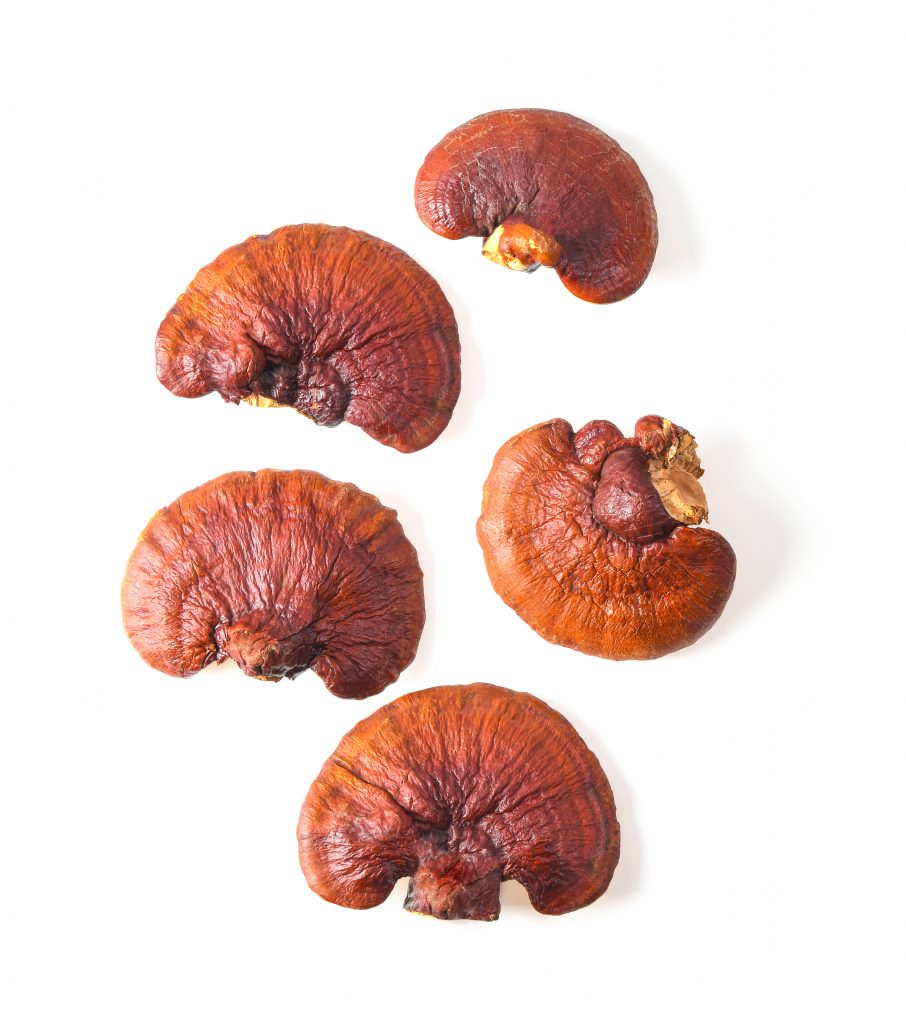
Health Benefits of Reishi
Reishi the Adaptogen
We all have stress in our lives, how we handle it is the truly important thing, as badly handled stress can place great pressure and tension on the adrenal glands and other organs of the body (such as the digestive system). Stressors can be common things, they can also include dietary choices, alcohol consumption smoking, and environmental toxins. We want to bring adaptogens into our body, like reishi, so that we can better cope with chronic stress and slowly bring balance back into our lives.
Red Reishi (G.lucidum) is a very potent adaptogen. By helping to strengthen the liver and kidneys along with aiding in detoxifying, reishi extract brings toxins out of the body alleviating pressure from the body. It improves the functioning of the lymphatic system, which helps in nourishing the body, removing waste and stimulating energy flow. Reishi is also showing potential benefits in improving the functioning of the adrenal glands (the organs that produce most of our hormones, including our stress hormone Cortisol) allowing an individual to better handle stress, exhaustion, and depression (Chaput, M., 2013).
Antioxidant
The antioxidant action of reishi is huge. Natural antioxidants found in functional food are far safer on the body than synthetic forms of antioxidants (Tan, W.C., 2015). Reishi is high in antioxidant flavonoids such as quercetin, rutin, myricetin and morin (Saltarelli, R., 2015). A very important protective aspect of reishi is its prevention of chemical damage to the kidney and liver. These organs filter a lot of toxins out of the body, making sure that they are functioning optimally is very important (Castleman, M., 2009). The antioxidant effect of reishi also has an antiageing ability as well as reducing free radical damage and are protective against oxidative stress to the body (which is another aspect of how they reduce cell aging (Tan, W.C., et al., 2015) (Castleman, M., 2009).
A 2016 study found that the fermentation of reishi in the form of a broth increased not only its antifungal activity but also its antioxidant benefits, as a result of more accessible phenol content. These benefits were observed in the highest abundance when used with the G.lucidum species of reishi (Cilerdzic J., Kosanic, M., et al., 2016).
Unrepaired or improperly repaired DNA can result in genetic damage or insults to the body. DNA damage can also occur from high levels of toxicity in the body, UV light or Xray damage and the consumption of a nutrient-poor diet which can lead to poor DNA development. Reishi is gamma protective – beneficial to consume during the summertime, UVB protective and blood cleansing. Another way for DNA to become damaged is when the pro/anti-oxidant balance is lost and the body becomes increasingly acidic leading to oxidative stress kicking into high gear. This begins to wreak havoc on the body, damaging DNA, RNA, tissues and organ function. Oxidative stress can lead to premature aging, extensive systemic inflammation, and carcinogenesis. Reishi is a natural antioxidant and aids in the elimination of free radical damage and oxidative stress. By bringing in more antioxidants into the body, oxidative stress is eliminated (Suarez-Arrayo, I.J., 2017).
Cancer
Reishi has been used as an anticancer therapy in Asia, with some researchers and doctors such as Bruno Donatini, finding that consistent regular therapeutic dosages of red reishi (G.lucidium) can reduce the causes of cancer by as much as 20% (Chaput, M., 2013). In Japan individuals with advanced cancer are given Reishi extract (Bharadvaj, D., 2008). Reishi is a very beneficial supplement to take during chemotherapy treatment and radiation. It has been shown to improve appetite, vigor, increasing recovery time, wound healing and increasing the body’s own production of its cancer-fighting ability. T cell count is also seen to increase, while T-suppressor cell count falls. Chances of developing leukopenia or intolerance to chemotherapy are greatly reduced (McKeenna, D.J., et al., 2011) (Castleman, M., 2009). Reishi supplementation also prevents new blood vessels from forming around and to tumors. This is known as angiogenesis inhibition and it prevents growth and starves the tumor in the patient(Castleman, M., 2009).
Breast cancer is the number one death-causing cancer in women in the United States. Many cancer patients relapsing after chemotherapy or radiation often as a result of a decreased immune system, poor gut health or resistance to antitumor medication. Using reishi in conjunction with chemotherapy and antitumor medication overcomes drug resistance, inhibits tumor growth and decreases tumor weight (Suarez-Arrayo, I.J., et al., 2017) – some studies showing about 50% reduction (Nonaka, Y., et al., 2008).
In 1977, Research in Japan discovered that Reishi had numerous beneficial properties specifically PSK (Polysaccharide K) to combat cancer (anti-cancer activity, anti-tumor activity). Since then PSK has been used in conjunction with other drugs, chemotherapy, and radiation. Reishi extract, given intravenously, has also been shown to reduce the side effects of both chemotherapy and radiation as well as increasing the rate of immune system repair during cancer recovery (Serrano, R.B., 2011)(Page, L., 2008).
Reishi should be supplemented seven days before therapy and 3 months after.
1.5 g x 2 daily (McKenna, D.J., et al., 2011).
Calm Mind
Since antiquity reishi has been used for its wonderful ability to combat stress and calm the mind, ease tension and strengthen the body all at the same time. This was why it was and is still known today as a “Mushroom of Spiritual Potency”. A part of life is about adapting to stressors, reishi aids the body in this, by being beneficial for the strengthening and maintenance of the adrenal glands. By addressing the adrenal glands and working as a tonic adaptogen it also being to increase our concentration and focus, helping to prevent our mind from shifting. Reishi also affects the brain by increasing brain plasticity which helps improve our memory and strengthen our nerves (Serrano, R.B., 2011).
Diabetes
Reishi powder has been shown to possess hyperglycemic effects on the body, making it very effective for individuals with diabetes. It aids in balancing blood sugar levels (Castleman, M., 2011). The polysaccharides in reishi aid in reducing blood sugar levels in diabetic patients (Chaput, M., 2013).
Immunomodulation
Reishi is beneficial to the individual if the immune system is excessive or deficient (Serrano, R.B., 2011). What this means is that if your immune system is overactive, such as in an autoimmune disease, or if you have a suppered immune system and you are constantly ill reishi aids in restoring balance to the function of the immune system.
Reishi also increases the secretion of immunoglobulin A (IgA) as well as increasing the mRNA levels int he small intestine, allowing for a reduction in the risk of intestinal infection and systemic infection (Kubota, A., et al., 2018). By reducing the risk of intestinal infection, primarily in the small intestine, Reishi aids in combating SIBO and candida overgrowth, thus preventing bloating, indigestion, heartburn and allowing for proper nutrient uptake from food.
In Korea, reishi is used in combination with antibiotics and it has been found that this combination is much more effective at eradicating infections than antibiotics alone (Castleman, M., 2009).
Herpes
Reishi mushroom aids in the healing of herpes, both genital and cold sores (Castleman, M., 2009).
Supplement with between 50-200mg of reishi powder 2xdaily (ibid).
Hypertension
Reishi has been shown to improve systemic blood pressure. In a 1996 study involving 54 patients with stage II hypertension, a vast majority of them saw great relief within 14 days of reishi supplementation (approximately 220mg daily) (McKenna, D.J., et al., 2011). Reishi also contains the nucleotide adenosine which is beneficial as a muscle relaxant and aids in reducing blood clotting (Chaput, M., 2013).
Hepatic Disease (Hepatitis)
2g of reishi powder as a tea has been shown to bring down serum bilirubin levels of Hepatitis B (McKenna, D.J., et al., 2011). It is the steroids in reishi that bring about a reduction in inflammation of the liver and hepatitis infections (Chaput, M., 2013).
Reishi as a Prebiotic and Probiotic
Reishi is an important prebiotic that can be used for feeding and growing healthy gut bacteria. It is because it is so rich in polysaccharides that it is such a super prebiotic, the terpenoids and phenols in it as well as fiber content also aid in feeding good bacteria in the gut. When reishi is fermented it contains even higher levels of prebiotics, which particularly aids in the increase of bifidobacteria in the digestive system. The fermentation of reishi also adds probiotic cultures to the mushroom, such as lactobacillus, roseburia, and lachnospiraceae. These cultures were present in the mushroom when it was fermented for over 18 hours (Jayachandran, M., et al., 2017).
Wild Crafting and Harvesting Reishi
When collecting reishi in the wild make sure to only harvest fresh conks, that are at full growth and have already lost their spores. The time varies on the species, some being harvested in early spring while others in late summer. Old reishi should not be harvested as they have the potential to contain mold and may be toxic. Though some varieties can be consumed fresh it is best to dehydrate the reishi and ones it is dry throw it in the freezer overnight to make sure that if there are any horned fungus beetle eggs they are destroyed (Marley, G., 2009).
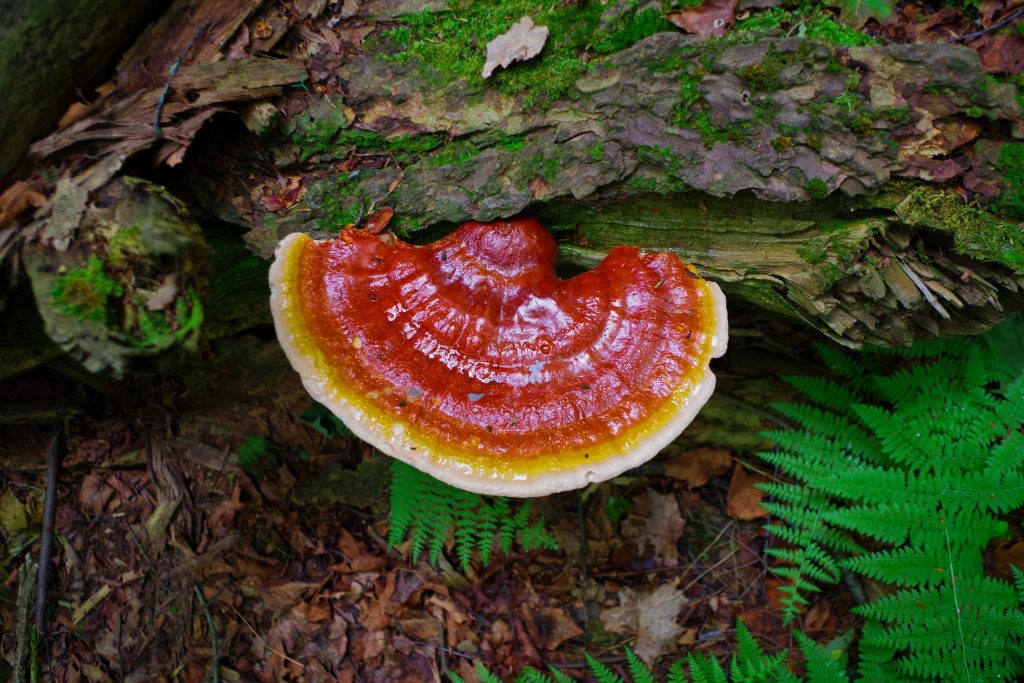
Supplementing with Reishi
There are so many wonderful Reishi supplements on the market today. Consuming fresh reishi can be difficult if it does not grow locally to you and it can be time-consuming if you don’t know how to prepare it. Reishi powder is great to throw into shakes, snacks, hot chocolate and a capsule is great for on the go benefits – please note though, reishi will not completely dissolve and disappear into the beverage that you make, I have seen some people complain about this, but there is nothing to fret about, into smoothies it incorporates very well, hot chocolate or even tea, you may end up with some residue on the bottom of your cup. There are a lot of great products on the market that provides a very good source of reishi, below are a list of a few that I find work and taste great.
Sun Potion – Reishi
Sun Potion blends are fantastic, they are made from wild-harvested and organic herbs and mushrooms and other adaptogens. This Reishi powder contains active beta and hetero-beta-glucans, as well as Ganoderma acid triterpenes. This makes the powder incredibly bioavailable. It is the perfect addition to smoothies, coffee or even used to make dashi stock.
Birch Boys – Reishi & Rose Hips Tea Bags
Birch Boys Red Reishi and Rose Hip Tea is made from 100% Wild Harvested red reishi from the Adirondack Mountains in northeastern New York. It is a perfect beverage to have in the morning as it stimulates the mind and digestive system. Red reishi was traditionally prepared as a tea. The addition of the rosehip provides an extra antioxidant boost further increasing the beverage’s free radical savaging ability. They also have a wonderful Red Reishi Tincture you can find on their website.
Mikei – Red Reishi Essence 30 caps
This product may be more on the expensive side but it is worth every penny. I have personally tried it and it works wonders. If you are looking for more from reishi than just a calm mind, if you want additional cancer-fighting benefits, immune-boosting power this is the supplement for you. The Mikei company does a fantastic job of producing the highest quality of red reishi supplements on the market. They take time with the extraction process so that all the benefits of this amazing mushroom are found in every one of their capsules.
Host Defence – Reishi Mushroom Capsules
Host Defence is a phenomenal supplement company. This capsule is perfect if you don’t like adding powders to your coffee or smoothies. This capsule contains activated, freeze-dried, Certified Organic mycelium, as well as the necessary plant constituents from reishi that provide it with its benefits such as polysaccharides, glycoproteins, ergosterols, and triterpenoids. Host Defence also has a reishi liquid dropper, a mixed mushroom capsule as well as a reishi powder.
Reishi Dosage
Dosage is dependant on what the supplement is entailed for, is it simply for adaptogenic purposes and is being used for maintenance or is it for therapeutic purposes and is needed to give the body a much-needed boost to fight off illness.
2-5 g daily – chronic health issues
1 1/2 g -9g – daily crude dried mushroom – maintenance dosage
1 1/2 g dried mushroom powder daily – maintenance dosage
Tablet 1 g 3xdaily
(Page, L., 2008).
Side Effects of Reishi
There are varying opinions about the side effects of Reishi. From my research most reports and evidence point towards no negative effects of consuming the mushroom. However, as opinions are varying let’s take a look at what is being stated for side effects. I do personally recommend, as with all potent herbs and functional foods start with a small dose and work your way up.
I would recommend that pregnant and nursing mothers as well as for children under the age of two to speak with their doctor, naturopath or herbalist on the whether or not reishi is right for them. Individuals taking medication, such as anticoagulants, antiplatelet, antihypertensive and immunosuppressant medication such also consult their health practitioner or naturopath about the supplementing or consuming reishi. Reishi has similar actions to these medications and that can pose a problem (Cassileth, B.R., et al., 2010).
200g – dangerously potent dosage ( McKenna, D.J., et al., 2011).
References
Balch, P.A., (2003). Prescriptions for Dietary Wellness. Penguin Group: New York.
Cassileth, B.R., Yeung, K.S., Gubili, J. (2010). Herb-Drug Interactions in Oncology. People’s Medical Publishing House: Connecticut.
Chaput, M. (2013). Japanese Red Reishi. The Champion of Mushrooms. World Health Publishing Inc. Canada.
Cilerdzic, J., Kosanic, M., Stajic, M., Vukojevic, J., Rankovic, B. (2016). Species of Genus Ganoderma (Agaricomycetes) fermentation Broth: A Novel Antioxidant and Antimicrobial Agent. International Journal of Medicinal Mushrooms. Volume 18, Issue 5, pages 397-404.
Cilerdzic, J., Sttajic, M., Vukjevic, J. (2016). Potential of Submergedly Cultivated Mycelia of Ganoderma spp. as Antioxidant and Antimicrobial Agents. Current Pharmaceutical Biotechnology. Volume 17, Issue 3, Pages 275-282.
Hobbs, C. (1986). Medicinal Mushrooms: An exploration of Tradition, Healing & Culture. Botanica Press: Tennessee.
Hsu, C.L., & Yen, G.C. (2014). Ganoderic Acid and Lucidenic Acid (Triterpenoid). Enzymes. Volume 36, Pages 33-56.
Kubota, A., Kobayashi, M., Sarashina, S., Takeno, R., Okamoto, K., Narumi, K., Furugen, A., Takahashi, N., Iseki, K. (2018). Reishi Mushroom Ganoderma lucidum Modulates IgA. production and alpha-defensin expression in the rat small intestine. Journal of Ethnopharmacology. Volume 214, pages 240-243. Online Available at PubMed.
Kuhar, F., Postemsky, P.D., Bianchinotti, M.V. (2018). Conditions Affecting Lingshi or Reishi Medicinal Mushroom Ganoderma lucidum (Agaricomycetes) Basidiome Quality, Morphogenesis, and Biodegradation of Wood By-Products in Argentina. International Journal of Medicinal Mushrooms. Volume 20, Issue 5, pages 495-506. Online Available at PubMed.
Marley, G. (2009). Mushrooms for Health: Medicinal Secrets of Northeastern Fungi. DownEast.
McKenna, D.J., Jone, K., Hughes, K., Tyler, V.M. (2011). Botanical Medicines: The Desk Reference for Major Herbal Supplements, Second Edition. Routledge Taylor & Francis Group; New York.
Meunick, J. (2015). Basic Illustrated Edible and Medicinal Mushrooms. Rowman & Littlefield: Montana.
Nonaka, Y., Ishibashi, H., Nakai, M., Shibata, H., Kiso, Y., Abe, S. (2008). Effects of the Antlered form of Ganoderma lucidum on Tumor Growth and Metastasis in Cyclophosphamide – Treated Mice. Food and Nutrition Science Regular Papers. Volume 72, Issue 6, page 1399-1408.
Obodai, M., Mensah, D.L.M., Fernander, A., Kortei, N.K., Dzomeku, M., Teegarden, M., Schwartz, S.J., Barros, L., Prempeh, J., Takli, R.K., Ferreira, I.C.F.R. (2017). Chemical Characterization and Antioxidant Potential of wild Ganoderma Species from Ghana. Molecules, Volume 22, Issue 2, page 196.
Page, L. (2008). Healthy Healing Detoxification. Programs to Cleanse, Purify and Renew. Healthy Healing LLC.
Saltarelli, R., Ceccaroli, P., Buffalini, M., Vallorani, L., Casadeli, L., Zamkonelli, A., Iotti, M., Bodalyan, S., Stocchi, V. (2015). Biochemical Characterization and Antioxidant and Antiproliferative Activities of Different Ganoderma Collections. Journal of Molecular Microbiology and Biotechnology. Volume 25, pages 16-25.
Serrano, R.B. (2011). Meditation and Qigong Mastery. Holisticwebs.com: Vancouver.
Suarez-Arrayo, I.J., Loperena-Alvarez, Y., Rosario-Acevedo, R., Martinez-Montemayor, M.M. (2017). Ganoderma spp.: A promising Adjuvant Treatment for Breast Cancer. Medicines. Volume 4, Issue 1. Online Available at PubMed.
Tan, W.C., Kuppusamy, U.R., Pan, C.W., Tan, Y.S., Raman, J., Anuar, A.M., Sabaratham, V. (2015). Ganoderma neo-japonicum Imazeki revisited: Domestication study and antioxidant properties of its basidiocarps and mycelia. Scientific Reports. Volume 5. Article Number 12515. Online Available at PubMed.
Jayachandran, M., Xiao, J., Xu, B. (2017). A Critical Review on Health Promoting Benefits of Edible Mushrooms Though Gut Microbiota. International Journal of Molecular Science. Volume 8, Issue 18, page 9.
Amanda Filipowicz is a certified nutritional practitioner (CNP) with a bachelor in environmental studies (BES) from York University. She also has certification in clinical detoxification, prenatal and postnatal care as well as nutrition for mental health. She has been working as a nutritionist since 2013 and is a lifelong proponent of eating healthy.

